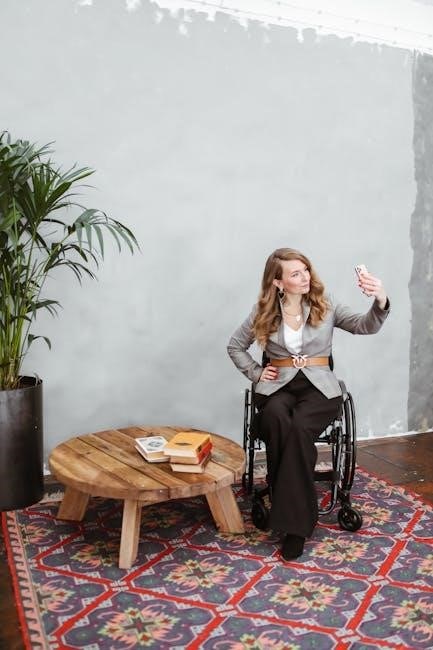How to Use a Gait Belt Safely and Effectively
- Always inspect the gait belt for wear and tear before use to ensure safety and durability.
- Ensure the belt is snug but not tight, allowing for proper movement and comfort.
- Use proper lifting techniques, keeping the patient upright and centered to maintain balance.
- Provide clear instructions to the patient to promote cooperation and stability during mobility.
- Monitor the patient’s comfort and adjust the belt as needed to prevent discomfort or restriction.

Understanding the Purpose of a Gait Belt

A gait belt is a essential tool used to assist patients or individuals with mobility challenges during walking or transfers. Its primary purpose is to provide stability, balance, and support, ensuring the safety of both the patient and the caregiver. The belt is typically worn around the patient’s waist, allowing the caregiver to guide and steady them effectively. It helps prevent falls and injuries by providing a secure grip and maintaining proper body mechanics during movement. Understanding the purpose of a gait belt is crucial for its safe and effective use, as it enables caregivers to provide the necessary support while respecting the patient’s independence. By using a gait belt correctly, caregivers can promote confidence and independence in patients, making the rehabilitation or mobility process more comfortable and efficient for everyone involved.
Preparing the Gait Belt
Before using a gait belt, proper preparation is essential to ensure safety and effectiveness. Begin by inspecting the belt for any signs of wear, such as cracks or frayed edges, and ensure it is clean. Adjust the belt to the correct size for the patient, ensuring it fits comfortably around their natural waistline. Demonstrate the use of the belt to the patient, explaining its purpose and how it will assist with mobility. Guide the patient to stand upright and fasten the belt securely, making sure it is snug but not restrictive. Ensure the caregiver’s hands are positioned correctly on the belt, with one hand on either side of the patient’s hips, to provide optimal support and control. Communicate clearly with the patient, instructing them to hold onto a stable object if needed, and ensure the environment is clear of obstacles before beginning the transfer or walking process.

Proper Application

Proper application of a gait belt is crucial for ensuring both patient safety and caregiver confidence; Begin by standing in front of the patient and explaining the process to encourage cooperation. Place the gait belt around the patient’s natural waistline, ensuring it is centered and snug but not restrictive. Adjust the buckle to a secure position, avoiding pressure on sensitive areas. The belt should allow for natural movement while providing sufficient support. If the patient is seated, assist them in standing slowly before finalizing the belt’s position. Ensure the patient’s clothing is smooth and untucked to prevent discomfort. Always involve the patient in the process, allowing them to hold onto a stable object if needed. Proper application ensures stability and balance, making the transfer or walking process safer and more effective for both parties. By following these steps, caregivers can create a secure and comfortable environment for mobility assistance.
Holding the Gait Belt
Holding the gait belt correctly is essential for maintaining control and ensuring the patient’s safety during mobility. Stand facing the patient and grasp the belt firmly on both sides, just above the patient’s hips. Keep your elbows slightly bent and your posture straight to maintain balance. Avoid holding the buckle, as this can cause uneven pressure. Instead, grip the sides of the belt securely, ensuring your hands are positioned to provide optimal support. When assisting the patient to walk, move in sync with their steps, keeping the belt taut but not overly tight. If the patient begins to lose balance, gently guide them toward a stable position without jerking the belt. Always maintain a slight tension on the belt to provide stability but avoid pulling too hard, as this could cause discomfort or imbalance. Proper handling ensures the patient feels secure while allowing for natural movement. This technique promotes confidence and safety for both the patient and caregiver during transfers or ambulation.

Safety Considerations
Using a gait belt requires careful attention to safety to prevent accidents and ensure the well-being of both the patient and caregiver. Always obtain the patient’s consent and ensure they are comfortable with the use of the gait belt. Inspect the belt for any signs of wear, such as frayed edges or damaged buckles, before each use. Avoid using the belt on patients with certain medical conditions, such as severe spinal injuries or fragile skin, unless medically advised. Ensure the patient’s clothing is secure and will not interfere with the belt’s placement. Never leave the patient unattended while the gait belt is in use, as this could lead to falls or other injuries. Additionally, ensure the area is clear of obstacles to prevent tripping. Proper training is essential to avoid improper handling, which could result in strain or harm to either party. Always prioritize the patient’s dignity and comfort, adjusting the belt as needed to avoid pressure points or discomfort.
Training and Techniques
Proper training is essential to use a gait belt effectively and safely. Caregivers should receive hands-on instruction and demonstration to master the techniques. Start by practicing with a cooperative patient or mannequin to build confidence and skill. Emphasize maintaining proper posture and using leg muscles rather than back strength to lift or assist the patient. Techniques include standing facing the patient, holding the belt firmly at the sides, and guiding their movement with gentle, steady pressure. Ensure the patient’s weight is evenly distributed and their feet are shoulder-width apart for stability. Avoid jerking or pulling abruptly, as this could cause loss of balance. Always maintain eye contact and communication to reassure the patient and coordinate movements. Trainees should also learn how to adjust the belt and reposition the patient without causing discomfort. Regular practice and feedback from instructors are crucial to refine these skills and prevent bad habits. Proper technique not only enhances safety but also promotes the patient’s independence and dignity during mobility assistance.
Alternatives to Gait Belts

While gait belts are widely used, there are alternative tools and methods that can assist with patient mobility. For patients with limited strength or balance issues, a transfer belt or slide board may be more appropriate. Canes, walkers, or wheelchairs are also effective for patients who can bear weight but need additional support. Non-slip footwear or orthotic devices can improve stability and reduce the risk of falls. In some cases, mechanical lifts or hoists are used for patients who require full assistance with transfers. These alternatives should be selected based on the patient’s specific needs, mobility level, and medical condition. Always consult with a healthcare professional to determine the most suitable option. Proper training and assessment are crucial to ensure the safe and effective use of any mobility aid. By exploring these alternatives, caregivers can provide personalized support and enhance patient safety during transfers and ambulation.
Common Mistakes to Avoid
When using a gait belt, it’s essential to avoid common mistakes that can compromise safety and effectiveness. One of the most frequent errors is improper positioning of the belt, which can lead to discomfort or loss of control during transfers. Always ensure the belt is centered and snug around the patient’s waist or torso. Another mistake is using excessive force or jerking movements, which can cause injury or loss of balance. Caregivers should also avoid relying solely on the belt for lifting, as this can strain their back and put the patient at risk. Additionally, never leave the belt on the patient when not in use, as it may cause tripping or entanglement hazards. Proper training and adherence to guidelines are crucial to prevent these mistakes and ensure safe, effective transfers. By being mindful of these common pitfalls, caregivers can enhance patient safety and promote a smoother mobility process.

Patient and Caregiver Education
Patient and caregiver education is a critical component of safe and effective gait belt use. Both the patient and caregiver must understand the proper techniques and purposes of the gait belt to ensure a collaborative and safe transfer process. Caregivers should receive comprehensive training on how to apply, hold, and use the belt correctly, as well as how to monitor the patient’s comfort and balance. Patients should be informed about their role in the process, such as maintaining proper posture and following instructions. Clear communication between the patient and caregiver is essential to avoid misunderstandings and ensure smooth transfers. Additionally, caregivers should be educated on how to handle emergency situations, such as a patient losing balance or experiencing discomfort. Regular practice and reinforcement of proper techniques can help build confidence and competence for both parties. Educational materials, such as instructional guides or videos, can serve as valuable resources to reinforce learning and promote consistent practices.
Continuous Monitoring and Adjustment
Continuous monitoring and adjustment are essential to ensure the safe and effective use of a gait belt during patient transfers. Caregivers must remain vigilant and attentive to the patient’s condition, posture, and comfort throughout the process. Regularly checking the belt’s position and fit is crucial to prevent it from becoming too tight or causing discomfort. Adjustments should be made as needed to accommodate changes in the patient’s movement or balance. Additionally, the caregiver should be prepared to respond to any signs of distress or instability, such as a patient leaning too far or losing balance. Monitoring the patient’s physical responses, such as facial expressions or verbal cues, can help identify the need for immediate adjustments. Over time, caregivers may also need to reassess the gait belt’s suitability for the patient’s evolving needs, such as changes in mobility or weight. By maintaining a proactive approach to monitoring and adjusting, caregivers can enhance safety and ensure a positive transfer experience for the patient.